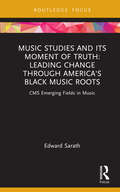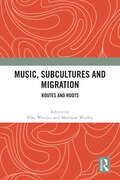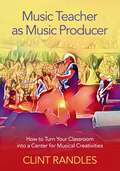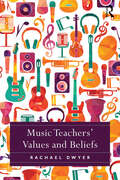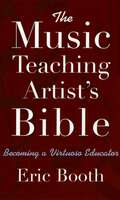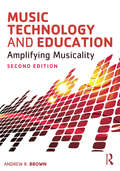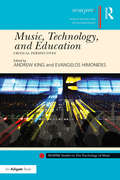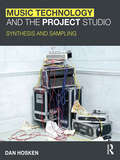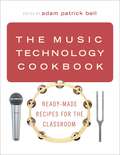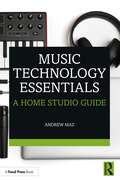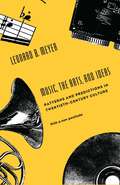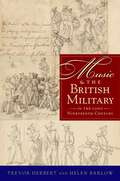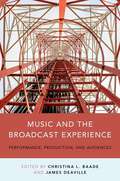- Table View
- List View
Music Studies and Its Moment of Truth: CMS Emerging Fields in Music (CMS Emerging Fields in Music)
by Edward SarathMusic Studies and Its Moment of Truth: Leading Change through America’s Black Music Roots presents a new framework for racial justice discourse in the context of music studies and education. Centering on Black American Music, the book issues challenges to both the conventional music studies paradigm and decades-old reform efforts.While Black American Music ranks high among America’s contributions to world culture, and offers musicians powerful tools for musical practice and understanding, this musical legacy remains remarkably marginalized even in activist conversations. The author argues that this reflects lingering and unexamined racist patterns that persist even among the most fervent voices for anti-racist interventions, and addresses the need for a higher-order activist framework within music studies.Delving further into the transformative changes needed to pursue racial justice, the short pieces collected in this book discuss topics including a shift from multicultural ideology to a transcultural model of musical pluralism, analysis of the multi-tiered nature of musical racism, the whitewashing of music studies activism, K-12 music teacher education as the locus for paradigmatic change and the potential for a transformed model of music studies to catalyze an overarching revolution in creativity and consciousness in both education and society at large. Critiquing the failures of progressive reform efforts and conventional reaction, this book argues that major changes are needed to the discourse on racism in music studies, and envisions new paradigms for the future.
Music, Subcultures and Migration: Routes and Roots
by Elke Weesjes Matthew WorleyThis edited volume concentrates on the period from the 1940s to the present, exploring how popular music forms such as blues, disco, reggae, hip hop, grime, metal and punk evolved and transformed as they traversed time and space. Within this framework, the collection traces how music and subcultures travel through, to and from democracies, autocracies and anocracies.The chosen approach is multidisciplinary and deliberately diverse. Using both archival sources and oral testimony from a wide variety of musicians, promoters, critics and members of the audience, contributors from a range of academic disciplines explore music and subcultural forms in countries across Asia, Europe, Oceania, North America and Africa. They investigate how far the meaning of music and associated subcultures change as they move from one context to another and consider whether they transcend or blur parameters of class, race, gender and sexuality.
Music, Subcultures and Migration: Routes and Roots
This edited volume concentrates on the period from the 1940s to the present, exploring how popular music forms such as blues, disco, reggae, hip hop, grime, metal and punk evolved and transformed as they traversed time and space. Within this framework, the collection traces how music and subcultures travel through, to and from democracies, autocracies and anocracies.The chosen approach is multidisciplinary and deliberately diverse. Using both archival sources and oral testimony from a wide variety of musicians, promoters, critics and members of the audience, contributors from a range of academic disciplines explore music and subcultural forms in countries across Asia, Europe, Oceania, North America and Africa. They investigate how far the meaning of music and associated subcultures change as they move from one context to another and consider whether they transcend or blur parameters of class, race, gender and sexuality.
Music Teacher as Music Producer: How to Turn Your Classroom into a Center for Musical Creativities
by Clint RandlesNever has there been such an exciting time to be a music teacher. Band, choir, and orchestra are ubiquitous in schools and have come to be known as the primary mode that students experience music at the secondary level. Similarly, elementary school classrooms feature approaches by Orff, Kodaly, Dalcroze, and Music Learning Theory, among a host of others. But, what is next? In this enlightening guide, author Clint A. Randles provides music educators with the practical tools to turn their classrooms into student production studios. Addressing everything from a new conceptualization of the physical classroom space to the cables and other audio equipment no music educator should be without, Randles puts creativity, technology, recording arts, songwriting, music production, and live performance at the center of music classrooms.
Music Teacher as Music Producer: How to Turn Your Classroom into a Center for Musical Creativities
by Clint RandlesNever has there been such an exciting time to be a music teacher. Band, choir, and orchestra are ubiquitous in schools and have come to be known as the primary mode that students experience music at the secondary level. Similarly, elementary school classrooms feature approaches by Orff, Kodaly, Dalcroze, and Music Learning Theory, among a host of others. But, what is next? In this enlightening guide, author Clint A. Randles provides music educators with the practical tools to turn their classrooms into student production studios. Addressing everything from a new conceptualization of the physical classroom space to the cables and other audio equipment no music educator should be without, Randles puts creativity, technology, recording arts, songwriting, music production, and live performance at the center of music classrooms.
Music Teachers' Values and Beliefs
by Rachael DwyerIn Music Teachers' Values and Beliefs, Dwyer investigates the relationships between teachers, learners and music in music classrooms. Using Bourdieu's concepts of habitus and doxa as an interpretive lens, the book explores the values and beliefs of four music teachers, depicted in richly detailed narratives. The narratives are contextualised through the examination of traditions of music and contemporary approaches. In the past, music education has been shaped by elitist tendencies regarding the types of music worthy of study, the ways in which music should be learnt, and the purpose of such learning. Contemporary approaches to music education have enacted significant change in some regions and systems, while others have been slower to leave behind deeply entrenched values, beliefs and practices. These approaches have been blamed for low rates of participation and engagement in school music education, despite the fact that the majority of young people listen to and enjoy music outside of school. This innovative book provides music education researchers and practitioners with a new understanding of the impact of teachers' personal values, beliefs and experiences of music and music education on classroom practice, and the impact this has on students' experiences of music education.
Music Teachers' Values and Beliefs
by Rachael DwyerIn Music Teachers' Values and Beliefs, Dwyer investigates the relationships between teachers, learners and music in music classrooms. Using Bourdieu's concepts of habitus and doxa as an interpretive lens, the book explores the values and beliefs of four music teachers, depicted in richly detailed narratives. The narratives are contextualised through the examination of traditions of music and contemporary approaches. In the past, music education has been shaped by elitist tendencies regarding the types of music worthy of study, the ways in which music should be learnt, and the purpose of such learning. Contemporary approaches to music education have enacted significant change in some regions and systems, while others have been slower to leave behind deeply entrenched values, beliefs and practices. These approaches have been blamed for low rates of participation and engagement in school music education, despite the fact that the majority of young people listen to and enjoy music outside of school. This innovative book provides music education researchers and practitioners with a new understanding of the impact of teachers' personal values, beliefs and experiences of music and music education on classroom practice, and the impact this has on students' experiences of music education.
The Music Teaching Artist's Bible: Becoming a Virtuoso Educator
by Eric BoothWhen the artist moves into the classroom or community to educate and inspire students and audience members, this is Teaching Artistry. It is a proven means for practicing professional musicians to create a successful career in music, providing not only necessary income but deep and lasting satisfaction through engaging people in learning experiences about the arts. Filled with practical advice on the most critical issues facing the music teaching artist today--from economic and time-management issues of being a musician and teacher to communicating effectively with students--The Music Teaching Artist's Bible uncovers the essentials that every musician needs in order to thrive in this role. Author Eric Booth offers both inspiration and how-to, step-by-step guidance in this truly comprehensive manual that music teaching artists will turn to again and again. The book also includes critical information on becoming a mentor, succeeding in school environments, partnering with other teaching artists, advocating for music and arts education, and teaching private lessons. The Music Teaching Artist's Bible helps practicing and aspiring teaching artists gain the skills they need to build new audiences, improve the presence of music in schools, expand the possibilities of traditional and educational performances, and ultimately make their lives as an artists even more satisfying and fulfilling.
The Music Teaching Artist's Bible: Becoming a Virtuoso Educator
by Eric BoothWhen the artist moves into the classroom or community to educate and inspire students and audience members, this is Teaching Artistry. It is a proven means for practicing professional musicians to create a successful career in music, providing not only necessary income but deep and lasting satisfaction through engaging people in learning experiences about the arts. Filled with practical advice on the most critical issues facing the music teaching artist today--from economic and time-management issues of being a musician and teacher to communicating effectively with students--The Music Teaching Artist's Bible uncovers the essentials that every musician needs in order to thrive in this role. Author Eric Booth offers both inspiration and how-to, step-by-step guidance in this truly comprehensive manual that music teaching artists will turn to again and again. The book also includes critical information on becoming a mentor, succeeding in school environments, partnering with other teaching artists, advocating for music and arts education, and teaching private lessons. The Music Teaching Artist's Bible helps practicing and aspiring teaching artists gain the skills they need to build new audiences, improve the presence of music in schools, expand the possibilities of traditional and educational performances, and ultimately make their lives as an artists even more satisfying and fulfilling.
Music Technology and Education: Amplifying Musicality
by Andrew BrownMusic Technology in Education lays out the principles of music technology and how they can be used to enhance musical teaching and learning in primary and secondary education. Previously published as Computers in Music Education, this second edition has been streamlined to focus on the needs of today’s music education student. It has been completely updated to reflect mobile technologies, social networks, rich media environments, and other technological advances. Topics include: Basic audio concepts and recording techniques Enhanced music instruction with interactive systems, web-based media platforms, social networking, and musicianship software Administration and management of technology resources Distance education and flexible learning Music Technology in Education provides a strong theoretical and philosophical framework for examining the use of technology in music education while outlining the tools and techniques for implementation in the classroom. Reflective Questions, Teaching Tips, and Suggested Tasks link technology with effective teaching practice. The companion website provides resources for deeper investigation into the topics covered in each chapter, and includes an annotated bibliography, website links, tutorials, and model projects.
Music Technology and Education: Amplifying Musicality
by Andrew BrownMusic Technology in Education lays out the principles of music technology and how they can be used to enhance musical teaching and learning in primary and secondary education. Previously published as Computers in Music Education, this second edition has been streamlined to focus on the needs of today’s music education student. It has been completely updated to reflect mobile technologies, social networks, rich media environments, and other technological advances. Topics include: Basic audio concepts and recording techniques Enhanced music instruction with interactive systems, web-based media platforms, social networking, and musicianship software Administration and management of technology resources Distance education and flexible learning Music Technology in Education provides a strong theoretical and philosophical framework for examining the use of technology in music education while outlining the tools and techniques for implementation in the classroom. Reflective Questions, Teaching Tips, and Suggested Tasks link technology with effective teaching practice. The companion website provides resources for deeper investigation into the topics covered in each chapter, and includes an annotated bibliography, website links, tutorials, and model projects.
Music, Technology, and Education: Critical Perspectives (SEMPRE Studies in The Psychology of Music)
by Andrew King Evangelos HimonidesThe use of technology in music and education can no longer be described as a recent development. Music learners actively engage with technology in their music making, regardless of the opportunities afforded to them in formal settings. This volume draws together critical perspectives in three overarching areas in which technology is used to support music education: music production; game technology; musical creation, experience and understanding. The fourteen chapters reflect the emerging field of the study of technology in music from a pedagogical perspective. Contributions come not only from music pedagogues but also from musicologists, composers and performers working at the forefront of the domain. The authors examine pedagogical practice in the recording studio, how game technology relates to musical creation and expression, the use of technology to create and assess musical compositions, and how technology can foster learning within the field of Special Educational Needs (SEN). In addition, the use of technology in musical performance is examined, with a particular focus on the current trends and the ways it might be reshaped for use within performance practice. This book will be of value to educators, practitioners, musicologists, composers and performers, as well as to scholars with an interest in the critical study of how technology is used effectively in music and music education.
Music, Technology, and Education: Critical Perspectives (SEMPRE Studies in The Psychology of Music)
by Andrew King Evangelos HimonidesThe use of technology in music and education can no longer be described as a recent development. Music learners actively engage with technology in their music making, regardless of the opportunities afforded to them in formal settings. This volume draws together critical perspectives in three overarching areas in which technology is used to support music education: music production; game technology; musical creation, experience and understanding. The fourteen chapters reflect the emerging field of the study of technology in music from a pedagogical perspective. Contributions come not only from music pedagogues but also from musicologists, composers and performers working at the forefront of the domain. The authors examine pedagogical practice in the recording studio, how game technology relates to musical creation and expression, the use of technology to create and assess musical compositions, and how technology can foster learning within the field of Special Educational Needs (SEN). In addition, the use of technology in musical performance is examined, with a particular focus on the current trends and the ways it might be reshaped for use within performance practice. This book will be of value to educators, practitioners, musicologists, composers and performers, as well as to scholars with an interest in the critical study of how technology is used effectively in music and music education.
Music Technology and the Project Studio: Synthesis and Sampling
by Dan HoskenMusic Technology and the Project Studio: Synthesis and Sampling provides clear explanations of synthesis and sampling techniques and how to use them effectively and creatively. Starting with analog-style synthesis as a basic model, this textbook explores in detail how messages from a MIDI controller or sequencer are used to control elements of a synthesizer to create rich, dynamic sound. Since samplers and sample players are also common in today’s software, the book explores the details of sampling and the control of sampled instruments with MIDI messages. This book is not limited to any specific software and is general enough to apply to many different software instruments. Overviews of sound and digital audio provide students with a set of common concepts used throughout the text, and "Technically Speaking" sidebars offer detailed explanations of advanced technical concepts, preparing students for future studies in sound synthesis. Music Technology and the Project Studio: Synthesis and Sampling is an ideal follow-up to the author’s An Introduction to Music Technology, although each book can be used independently. The Companion Website includes: Audio examples demonstrating synthesis and sampling techniques Interactive software that allows the reader to experiment with various synthesis techniques Guides relating the material in the book to various software synthesizers and samplers Links to relevant resources, examples, and software
Music Technology and the Project Studio: Synthesis and Sampling
by Dan HoskenMusic Technology and the Project Studio: Synthesis and Sampling provides clear explanations of synthesis and sampling techniques and how to use them effectively and creatively. Starting with analog-style synthesis as a basic model, this textbook explores in detail how messages from a MIDI controller or sequencer are used to control elements of a synthesizer to create rich, dynamic sound. Since samplers and sample players are also common in today’s software, the book explores the details of sampling and the control of sampled instruments with MIDI messages. This book is not limited to any specific software and is general enough to apply to many different software instruments. Overviews of sound and digital audio provide students with a set of common concepts used throughout the text, and "Technically Speaking" sidebars offer detailed explanations of advanced technical concepts, preparing students for future studies in sound synthesis. Music Technology and the Project Studio: Synthesis and Sampling is an ideal follow-up to the author’s An Introduction to Music Technology, although each book can be used independently. The Companion Website includes: Audio examples demonstrating synthesis and sampling techniques Interactive software that allows the reader to experiment with various synthesis techniques Guides relating the material in the book to various software synthesizers and samplers Links to relevant resources, examples, and software
The Music Technology Cookbook: Ready-Made Recipes for the Classroom
Featuring 56 lessons by 49 music technology experts from around the world, The Music Technology Cookbook is an all-in-one guide to the world of music technology, covering topics like: composition (with digital audio workstations such as Ableton, Soundtrap, GarageBand); production skills such as recording, editing, and equalization; creating multimedia (ringtones, soundscapes, audio books, sonic brands, jingles); beatmaking; DJing; programming (Minecraft, Scratch, Sonic Pi, P5.js); and, designing instruments (MaKey MaKey). Each lesson tailored for easy use and provides a short description of the activity, keywords, materials needed, teaching context of the contributing author, time required, detailed instructions, modifications for learners, learning outcomes, assessment considerations, and recommendations for further reading. Music educators will appreciate the book's organization into five sections--Beatmaking and Performance; Composition; Multimedia and Interdisciplinary; Production; Programming--which are further organized by levels beginner, intermediate, and advanced. Written for all educational contexts from community organizations and online platforms to universities and colleges, The Music Technology Cookbook offers a recipe for success at any level.
MUSIC TECHNOLOGY COOKBOOK C: Ready-Made Recipes for the Classroom
by Adam Patrick BellFeaturing 56 lessons by 49 music technology experts from around the world, The Music Technology Cookbook is an all-in-one guide to the world of music technology, covering topics like: composition (with digital audio workstations such as Ableton, Soundtrap, GarageBand); production skills such as recording, editing, and equalization; creating multimedia (ringtones, soundscapes, audio books, sonic brands, jingles); beatmaking; DJing; programming (Minecraft, Scratch, Sonic Pi, P5.js); and, designing instruments (MaKey MaKey). Each lesson tailored for easy use and provides a short description of the activity, keywords, materials needed, teaching context of the contributing author, time required, detailed instructions, modifications for learners, learning outcomes, assessment considerations, and recommendations for further reading. Music educators will appreciate the book's organization into five sections--Beatmaking and Performance; Composition; Multimedia and Interdisciplinary; Production; Programming--which are further organized by levels beginner, intermediate, and advanced. Written for all educational contexts from community organizations and online platforms to universities and colleges, The Music Technology Cookbook offers a recipe for success at any level.
Music Technology Essentials: A Home Studio Guide
by Andrew MazMusic Technology Essentials provides an overview of the vocabulary, techniques, concepts, and devices used in contemporary music production and guides readers through the essential fundamentals of music technology so that they can create their own music productions at home. This highly accessible book covers sound fundamentals and theory, as well as practical topics like hardware, software, MIDI, digital audio, synthesis, computer notation, and audio-visual applications, to equip the reader with the principles they need to achieve professional-sounding results. Each chapter is accompanied by real-life examples and exercises that can be applied to any digital audio workstation software, to put the lessons into practice. This book will also help readers evaluate their requirements for home music production while working within a sensible budget. Music Technology Essentials is the ideal textbook for beginners inside and outside of the classroom, including those on music and music production courses, who wish to enter the world of music technology but are unsure where to start or what to purchase.
Music Technology Essentials: A Home Studio Guide
by Andrew MazMusic Technology Essentials provides an overview of the vocabulary, techniques, concepts, and devices used in contemporary music production and guides readers through the essential fundamentals of music technology so that they can create their own music productions at home. This highly accessible book covers sound fundamentals and theory, as well as practical topics like hardware, software, MIDI, digital audio, synthesis, computer notation, and audio-visual applications, to equip the reader with the principles they need to achieve professional-sounding results. Each chapter is accompanied by real-life examples and exercises that can be applied to any digital audio workstation software, to put the lessons into practice. This book will also help readers evaluate their requirements for home music production while working within a sensible budget. Music Technology Essentials is the ideal textbook for beginners inside and outside of the classroom, including those on music and music production courses, who wish to enter the world of music technology but are unsure where to start or what to purchase.
Music, the Arts, and Ideas: Patterns and Predictions in Twentieth-Century Culture
by Leonard B. MeyerMeyer makes a valuable statement on aesthetics, criteria for assessing great works of music, compositional practices and theories of the present day, and predictions of the future of Western culture. His postlude, written for the book's twenty-fifth anniversary, looks back at his thoughts on the direction of music in 1967.
Music, the Arts, and Ideas: Patterns and Predictions in Twentieth-Century Culture
by Leonard B. MeyerMeyer makes a valuable statement on aesthetics, criteria for assessing great works of music, compositional practices and theories of the present day, and predictions of the future of Western culture. His postlude, written for the book's twenty-fifth anniversary, looks back at his thoughts on the direction of music in 1967.
Music, the Arts, and Ideas: Patterns and Predictions in Twentieth-Century Culture
by Leonard B. MeyerMeyer makes a valuable statement on aesthetics, criteria for assessing great works of music, compositional practices and theories of the present day, and predictions of the future of Western culture. His postlude, written for the book's twenty-fifth anniversary, looks back at his thoughts on the direction of music in 1967.
Music, the Arts, and Ideas: Patterns and Predictions in Twentieth-Century Culture
by Leonard B. MeyerMeyer makes a valuable statement on aesthetics, criteria for assessing great works of music, compositional practices and theories of the present day, and predictions of the future of Western culture. His postlude, written for the book's twenty-fifth anniversary, looks back at his thoughts on the direction of music in 1967.
Music & the British Military in the Long Nineteenth Century
by Trevor Herbert Helen BarlowAlthough military music was among the most widespread forms of music making during the nineteenth-century, it has been almost totally overlooked by music historians. Music & the British Military in the Long Nineteenth Century however, shows that military bands reached far beyond the official ceremonial duties they are often primarily associated with and had a significant impact on wider spheres of musical and cultural life. Beginning with a discussion of the place of the military in civilian and social life, authors Trevor Herbert and Helen Barlow plot the story of military music from its sponsorship by military officers to its role as an expression of imperial force, which it took on by the end of the nineteenth century. Herbert and Barlow organize their study around three themes: the use of military status to extend musical patronage by the officer class; the influence of the military on the civilian music establishments; and an incremental movement towards central control of military music making by governments throughout the world. In so doing, they show that military music impacted everything from the configuration of the music profession in the major metropolitan centers, to the development of wind instruments throughout the century, to the emergence of organized amateur music making. A much needed addition to the scholarship on nineteenth century music, Music & the British Military in the Long Nineteenth Century is an essential reference for music, cultural and military historians, the social history of music and nineteenth century studies.
MUSIC & THE BROADCAST EXPERIENCE C: Performance, Production, and Audiences
by Christina L. Baade and James DeavilleMusic and the Broadcast Experience explores the complex ways in which music and broadcasting have developed together throughout the twentieth and into the twenty-first centuries. It brings into dialogue researchers working in media and music studies; explores and develops crucial points of contact between studies of music in radio and music in television; and investigates the limits, persistence, and extensions of music broadcasting in the Internet era. The book presents a series of case studies that address key moments and concerns in music broadcasting, past and present, written by leading scholars in the field, who hail from both media and music studies. Unified by attentiveness both to musical sound and meaning and to broadcasting structures, practices, audiences, and discourses, the chapters in this collection address the following topics: the role of live orchestral concerts and opera in the early development of radio and their relation to ideologies of musical uplift; the relation between production culture, music, and television genre; the function of music in sponsored radio during the 1930s; the fortunes of musical celebrity and artistic ambition on television; questions of music format and political economy in the development of online radio; and the negotiation of space, community, and participation among audiences, online and offline, in the early twenty-first century. The collection's ultimate aim is to explore the usefulness and limitations of broadcasting as a concept for understanding music and its cultural role, both historically and today.
